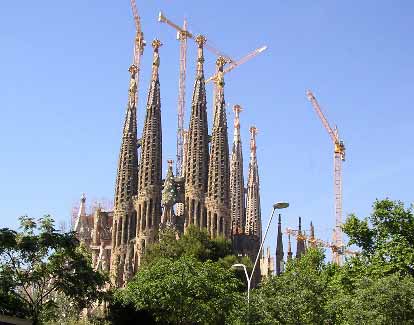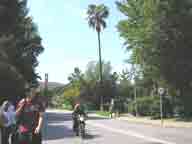To the north, Tibidabo, the highest mountain in Barcelona, will give you a view of the city that ends in the sea. The straight streets, the square blocks, and
La Sagrada Familia sit below the mountain’s lap. You’ll see the buildings at a lower level as a mantle around
La Sagrada Familia that looks below to the city from its towers. Up close, the blocks are not really square; they are octagons, leaving more space for the turning traffic.
In Tibidabo you will also find the Sacred Heart church and San Juan Bosco’s hermit. This last one was the first construction in the mountain. In order to find it, you’ll need to walk to the back of the church, on the right side. There is also an amusement park in Tibidabo.
Down south, close to the sea, you’ll find Montjuïc. This area has been renovated to include many attractions. But for some people in Barcelona, Montjuïc still carries fresh memories of Franco’s dictatorship and the executions that took place in the fort.
 In between, a city full of life, in constant reconstruction, with museums, historical sites, "ramblas", parks, big shopping malls, and hundredths of little stores to visit. The coffee shops invite you to stop and have a "cortado" with pastry. And the "locutorios" will allow you to call home to say hi or connect to the Internet to check your e-mail.
In between, a city full of life, in constant reconstruction, with museums, historical sites, "ramblas", parks, big shopping malls, and hundredths of little stores to visit. The coffee shops invite you to stop and have a "cortado" with pastry. And the "locutorios" will allow you to call home to say hi or connect to the Internet to check your e-mail.
 Barcelona is a city that outgrew its limits and absorbed the nearby communities. It is a city that grew inside, in between the big buildings on the edge of the squares, making room for the huge increase of population. The roofs became patios, spaces where to sit and rest; and a little imagination can make them a place to dream.
Barcelona is a city that outgrew its limits and absorbed the nearby communities. It is a city that grew inside, in between the big buildings on the edge of the squares, making room for the huge increase of population. The roofs became patios, spaces where to sit and rest; and a little imagination can make them a place to dream.
Vocabulary:
Rambla – pathway-plaza where people sit, walk, eat, buy, or is entertained by the street artists.
Cortado – half cup coffee, with milk, a little stronger than the full cup; in Puerto Rico “pocillo”
Locutorio – phone business that allows people to call anywhere in the world or connect to the Internet
Check the notes on the new readings from: Whitehurst, G. J. (2003); Middleton, et al. (2004); Lubienski, S. T. & Bowen, A. (2000); and Kilpatrick (2001).
 In between, a city full of life, in constant reconstruction, with museums, historical sites, "ramblas", parks, big shopping malls, and hundredths of little stores to visit. The coffee shops invite you to stop and have a "cortado" with pastry. And the "locutorios" will allow you to call home to say hi or connect to the Internet to check your e-mail.
In between, a city full of life, in constant reconstruction, with museums, historical sites, "ramblas", parks, big shopping malls, and hundredths of little stores to visit. The coffee shops invite you to stop and have a "cortado" with pastry. And the "locutorios" will allow you to call home to say hi or connect to the Internet to check your e-mail.
 Barcelona is a city that outgrew its limits and absorbed the nearby communities. It is a city that grew inside, in between the big buildings on the edge of the squares, making room for the huge increase of population. The roofs became patios, spaces where to sit and rest; and a little imagination can make them a place to dream.
Barcelona is a city that outgrew its limits and absorbed the nearby communities. It is a city that grew inside, in between the big buildings on the edge of the squares, making room for the huge increase of population. The roofs became patios, spaces where to sit and rest; and a little imagination can make them a place to dream.
 Today has been very productive. I have edited an old paper and submitted it for publication. It is interesting how working with a document after reconsidering its contents in different ways, makes you visualize it differently. Integrating old and new ideas is just part of the job. You look at the construction of the sentences, you check the grammar and selection of words, you move around its contents and almost without noticing it, it becomes something new, different, and hopefully better. We’ll see what happens!
Today has been very productive. I have edited an old paper and submitted it for publication. It is interesting how working with a document after reconsidering its contents in different ways, makes you visualize it differently. Integrating old and new ideas is just part of the job. You look at the construction of the sentences, you check the grammar and selection of words, you move around its contents and almost without noticing it, it becomes something new, different, and hopefully better. We’ll see what happens!




